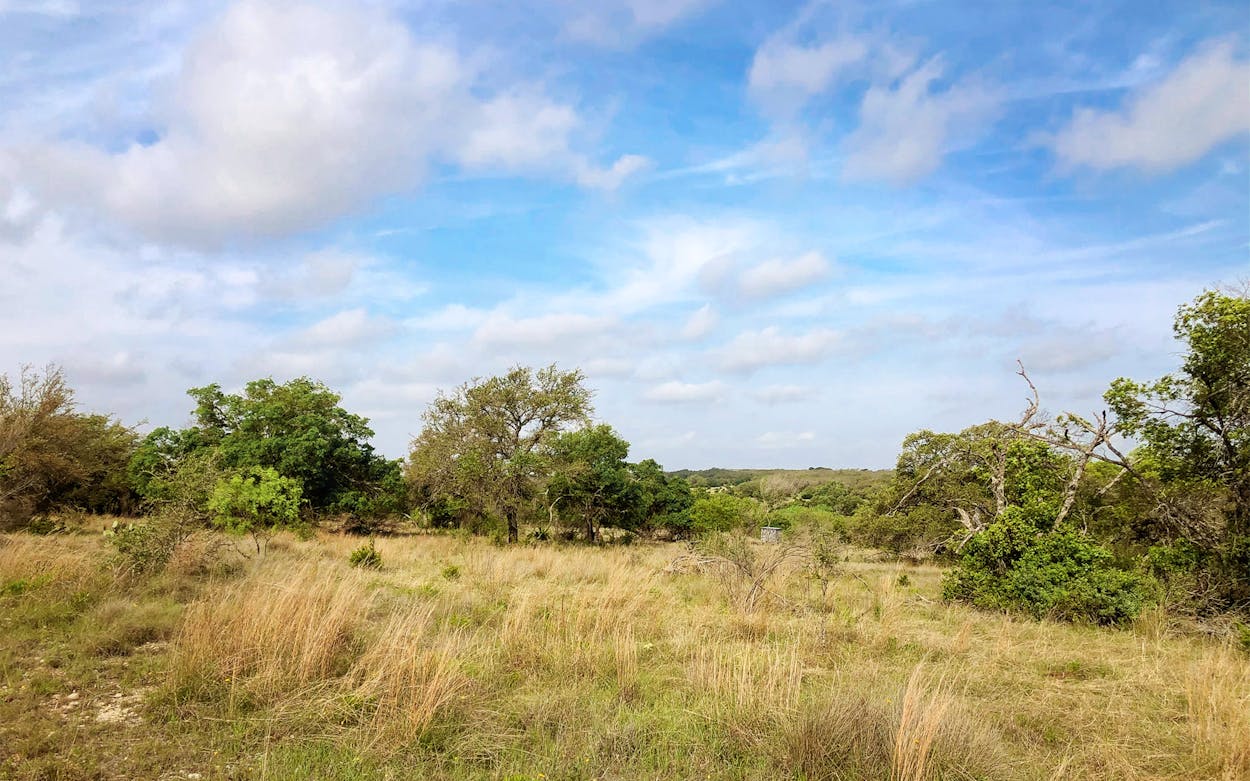What: 367 acres of rolling Hill Country ranch land that will be permanently preserved.
Who: Landowner Scott Shannon and the Hill Country Conservancy.
Why it’s so great: More than 96 percent of the state’s land is privately owned. That means landowners hold a lot of power to preserve—or destroy—Texas’s clean water, vibrant wildlife, and scenic vistas. Scott Shannon has done the former with his spread of rolling hills, clustered oaks, and native grasses, located about fifty miles west of Austin. The land, which is between Johnson City and Fredericksburg, has been in his family for generations.
Shannon’s great-grandfather Charles Klett bought the original ranch a few miles west of Johnson City in the late 1800s. The family ran cattle on about 3,000 acres and left a relatively light footprint on the land. That acreage was ultimately divided up among family members, and when Shannon’s great-aunt Mamie Klett passed away decades ago, she left these 367 acres to him and his cousin (whose half Shannon eventually purchased).
Shannon, a retired military officer and teacher who lives in Lubbock, saw the land as a kind of “sacred trust,” and, having no heirs to pass it on to, he began to consider a conservation easement. The arrangement means that Shannon still owns the ranch, but now, and even after he has died or sold the property, the Hill Country Conservancy, an Austin nonprofit, will carefully manage the land in perpetuity to ensure that it remains mostly undeveloped, providing a crucial habitat for local wildlife and a source of clean water for nearby streams and aquifers. “I think that my predecessors who owned the land would have been happy with my decision,” Shannon says, noting that he couldn’t imagine what his forebears would make of the encroaching development—tourist attractions, residential developments, and an endless string of wineries—sprouting up along Highway 290 east of Fredericksburg. By 2030, the region’s population is expected to hit 4.3 million, nearly double what it was in 2000.
Land stewardship runs in the family. Shannon’s great-uncle Scott Klett was a school superintendent; according to Shannon, he taught social studies to President Lyndon B. Johnson. The ranch’s previous owner had told Scott Klett’s father, Charles, that there used to be a spring on the property, but it had long since run dry. In the late 1930s, many Hill Country landowners, including some of the Kletts’ neighbors, came to see the invasive, and very thirsty, cedar trees as an ecological disturbance. Seventy years after his father bought the ranch, Scott Klett cleared the cedar from the land. According to Robert Caro’s 1982 biography of LBJ, The Path to Power, Scott Klett reported the details of his land management to a county agent, adding, “The spring is running now.”
Running water is perhaps the most precious commodity in the Hill Country, and Shannon’s property contains 1.4 miles of a seasonal stream called Towhead Creek, which feeds the Pedernales River. Frank Davis, the chief conservation officer at Hill Country Conservancy, says the creek boosts the conservation value of the land. The Pedernales supplies the Highland Lakes west of Austin, which are the city’s source of water. That means water raining down on Scott Shannon’s ranch may eventually make its way into the taps of Austinites. “We’ve long been focused on promoting drinking water protection in any way that we can,” Davis says.
Shannon’s ranch is also a critical haven for many species facing increasing habitat loss as development booms in the Hill Country. The land is home to native flora and fauna ranging from bluebonnets and firewheels to white-tailed deer, bobcats, and armadillos. It’s also within the southern range of several migratory species of significant conservation concern, such as monarch butterflies, painted buntings, red-shouldered hawks, and scissor-tailed flycatchers.
While he acknowledges that he could have made a lot more money if he’d just held onto the land until a developer came knocking, Shannon says that turning a hefty profit on the property was never the goal. And he’s not alone in this sentiment; roughly 550,000 acres of the Hill Country and more than 1.9 million acres statewide have been protected under conservation easements and similar arrangements.
Decades ago, when Shannon first faced the question of what do with this land, he says the choice wasn’t immediately obvious. But as he started to consider the conservation easement, the idea just felt right. “It resonated with values I didn’t even realize I had,” Shannon says.
Those latent values bloomed into a full-blown commitment to land conservation. Ultimately, Shannon would like the property to turn into a conservation center. Perhaps the Hill Country Conservancy would take ownership and host star parties, nature walks, and educational sessions. Amid all the wineries, bed and breakfasts, and wedding venues that dot this bucolic patch of Texas, there may one day be the Scott Shannon Ranch Nature Center. “We all want to do something that’s important,” Shannon says. “I sort of feel like maybe this is my little bit of a chance to do something meaningful.”
- More About:
- Best Thing in Texas
- Johnson City






